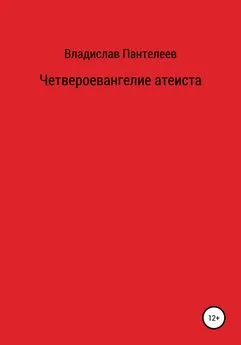Питер Богоссян - Евангелие от атеиста
- Название:Евангелие от атеиста
- Автор:
- Жанр:
- Издательство:Издательство «Питер»046ebc0b-b024-102a-94d5-07de47c81719
- Год:2015
- Город:Санкт-Петербург
- ISBN:978-5-496-01178-5
- Рейтинг:
- Избранное:Добавить в избранное
-
Отзывы:
-
Ваша оценка:
Питер Богоссян - Евангелие от атеиста краткое содержание
Внутри религиозной парадигмы объяснение находится всему – от великого до трагического, от карьерных перспектив до парковочных мест. Если человек принимает эту систему убеждений, она кажется ему внутренне согласованной и непротиворечивой… пока он не посмотрит на нее пристальнее и пока он окружен людьми одинаковых с ним взглядов.
Существует множество научных трактатов и философских книг, доказывающих наличие либо отсутствие Бога и касающихся главных догматов христианства, но ни одна из них не похожа на ту, которую вы держите в руках. Книга Питера Богоссяна и предложенный им метод «уличной эпистемологии» появились как ответ на небывалый расцвет в современном обществе различных религиозных общин и движений, претендующих на умы, сердца, а порой и кошельки своих адептов. Множество людей уже попалось на крючок их мягкой, но упорной пропаганды и очень нелегко порой достучаться до их рассудка и логики.
Эта книга поможет вам разубедить фанатика в его заблуждениях. Вы узнаете, как вовлечь верующего в разговор, который поможет ему оценить разумное и рациональное мышление, поставить под сомнение навязанные догматы и взглянуть фактам в лицо. Цель этой книги – вооружить антирелигиозного агитатора диалектическим инструментарием, научить применять разработанные автором приемы, стратегии и техники, которые он использовал в своей просветительской и философской деятельности при обучении десятков тысяч студентов в государственных университетах в течение более 25 лет.
«Евангелие от атеиста» – превосходное дополнение к книге Ричарда Докинса «Бог как иллюзия». Их следует «связать в одну сеть» как атеистическое программное обеспечение по перепрограммированию умов, которое заменяло бы веру разумом, а предрассудки – наукой.
Евангелие от атеиста - читать онлайн бесплатно ознакомительный отрывок
Интервал:
Закладка:
Bandura, A. (1990). Mechanisms of moral disengagement. InW. Reich (Ed.), Origins of terrorism: Psychologies, ideologies, theologies, states of mind (pp. 161–191). Washington, DC: Woodrow Wilson Center Press.
Bandura, A. (1999). Moral disengagement in the perpetration of inhumanities. Personality and Social Psychology Review, 3, 193–209. doi:10.1207/s15327957pspr0303_3
Bandura, A. (2002). Selective moral disengagement in the exercise of moral agency. Journal of Moral Education, 31(2), 102–119. doi:10.1080/ 0305724022014322
Bartlett, T. (2012, August 13). Dusting off God: A new science of religion says God has gotten a bad rap. The Chronicle of Higher Education. URL: http://chronicle.com/article/Does-Religion-Really-Poison/133457/
Barker, D.L. (Performer). (2012). Making the case for atheists. [Web Video]. URL: http://www.youtube.com/watch?v=e7y5slOkwaU&feature=player_embedded
Barker, D. (2008). Godless: How an evangelical preacher became one of America’s leading atheists. Berkeley, CA: Ulysses Press.
Bausell, R.B. (2007). Snake oil science: The truth about complementary and alternative medicine. Oxford: Oxford University Press.
Bering, J. (2011). The belief instinct: The psychology oj souls, destiny, and the meaning of life. New York, NY: W.W. Norton & Company, Inc.
Berns, G.S., Bell, E., Capra, С M., Prietula, M.J., Moore, S., Anderson, B.,… Atran, S. (2012). The price of your soul: Neural evidence for the non-utilitarian representation of sacred values. Philosophical Transactions of The Royal Society, 367(1589), 754–762. doi:10.1098/rstb.2011.0262
Bernstein, R., & Gaw, A. (1990). Кого: Proposed classification for DSMIV The American Journal oj Psychiatry, 747(12), 1670–1674.
Bishop, B. (2008). The big sort: Why the clustering oj like-minded America is tearing us apart. New York, NY: Houghton Mifflin Company.
Blackford, R. (2012a, August, 8). Islam, racists, and legitimate debate. Talking Philosophy: The Philosophers’ Magazine Blog. URL: http://blog.talkingphilosophy.com/?p=5305
Blackford, R. (2012b). Freedom of religion and the secular state. West Sussex, England: Wiley-Blackwell.
Blume, A.W., Schmaling, К.В., & Marlatt, G.A. (2000). Revisiting the self-medication hypothesis from a behavioral perspective. Cognitive and Behavioral Practice, 7(4), 379–384. doi:10.1016/S1077–7229(00)80048–6
Boghossian, P.A. (2006c). Fear of knowledge: Against relativism and constructivism. Oxford: Clarendon Press.
Boghossian, P. (2002a). Socratic pedagogy, race and power. Education Policy Analysis Archives, 10, 3. URL: http://epaa.asu.edu/ojs/article/view/282
Boghossian, P. (2002b). The Socratic method (or, having a right to get stoned). Teaching Philosophy, 25(4), 345–359. doi:10.5840/teachphil200225443
Boghossian, P. (2003). How Socratic pedagogy works. Informal Logic, 23(2), TS17–25.
Boghossian, P. (2004). Socratic pedagogy, critical thinking, moral reasoning and inmate education: An exploratory study. (Unpublished doctoral dissertation). Portland State University. Portland, OR.
Boghossian, P. (2006a). Socratic pedagogy, critical thinking, and inmate education. Journal oj Correctional Education, 57(1), 42–63.
Boghossian, P. (2006b). Behaviorism, constructivism, and Socratic pedagogy. Educational Philosophy and Theory, 38(6), 713–722. doi: 10.1111/j. 1469–5812.2006.00226.x
Boghossian, P. (2010). Socratic pedagogy, critical thinking, and offender programming. Offender Programs Report, 13(5), 65–80.
Boghossian, P. (2011a). Critical thinking and constructivism: Mambo dog fish to the banana. Journal of Philosophy of Education, 46(1), 73–84. doi: 10.1111/j. 1467–9752.2011.00832.x
Boghossian, P. (2011b). Socratic pedagogy: Perplexity, humiliation, shame and a broken egg. Educational Philosophy and Theory, 44(7), 710–720. doi:10.1111/j.1469–5812.2011.00773.x
Boghossian, P. (2011c, July). Should we challenge student be1iefs? Inside Higher Ed. URL: http://www.insidehighered.com/views/2011/07/192/boghossian
Boghossian, P. (2012). Faith no more. The Philosophers’ Magazine, 59, 15–16.
Bogue, В., Diebel, J., & O’Connor, T.P. (2008). Combining officer supervision skills: Anew model for increasing success in community corrections. Perspectives, Spring, 2(32), 30–45.
Bonta, J., & Andrews, D. (2010). Viewing offender assessment and rehabilitation through the lens of the risk-needs-responsivity model. In F. McNeill, P. Rayner & С Trotter (Eds.), Offender supervision: New directions in theory, research and practice (pp. 19–40). New York: Willan Publishing.
Bordin, E.S. (1979). The generalizability of the psychoanalytic concept of the working alliance. Psychotherapy: Theory, Research, and Practice, 16(3), 252–260.
Bortolotti, L. (2010). Delusions and other irrational beliefs. Oxford: Oxford University Press.
Bostrom, N. (2003). Are you living in a computer simulation? Thе Philosophical Quarterly, 53(211), 243–255.
Bostrom, N. (May/June 2008). Where are they?: Why I hope the search for extraterrestrial life finds nothing. MIT Technology Review. URL: http://www.technologyreview.com/article/409936/where-are-they/
Boyer, P. (2001). Religion explained: The evolutionary origins of religious thought. New York, NY: Basic Books.
Boyer, P. (2004, March/April). Why is religion natural? Skeptical Inquirer, 28.2, URL: http://www.csicop.org/si/show/why_is_religion_natural/
Braithwaite, V. & Levi, M. (Eds.). (1998). Trust and governance (Russell Sage Foundation series on trust, volume I). New York, NY: Russell Sage Foundation.
Brock, T.C., & Balloun, J.L. (1967). Behavioral receptivity to dissonant information. Personality and Social Psychology, 6(4, Pt.l), 413–428. doi:10.1037/h0021225
Brodie, R. (1996). Virus of the mind: The new science of the тете. Carlsbad, CA: Hay House, Inc.
Brown, S. (2012, October 2). The 10 most dangerous religious right organizations. Network for Church Monitoring. URL: http://www.alternet.org/belief/10-most-dangerous-religious-right-organizations
Brutus, S. (2012). Religion, Culture, History: A Philosophical Study of Religion. Portland, OR: Daimonion Press.
Carrier, R. (2012). Atheism IS an Identity. URL: http://freethoughtblogs.com/carrier/archives/337/
CBS News. (2012, August 16). More Americans identifying as atheists. URL: http://www.cbn.com/cbnnews/us/2012/August/More-Americans-Identifying-as-Atheist/
CDC. (2012). Centers for Disease Control and Prevention. URL: http://www.cdc.gov/24–7/CDCFastFacts.html
Chambers, A. (2009). Eats with sinners: Reaching hungry people like Jesus did. Cincinnati, OH: Standard Pub.
Christian, J.L. (Ed.). (2011). Philosophy: An introduction to the art of wondering. (11th ed., pp. 51). Boston, MA: Wadsworth.
Christina, G. (2012). Why are you atheists so angry? 99 things that piss off the Godless. Charlottesville, \A: Pitchstone.
Clarke, M.L. (1968). The Roman mind: Studies in the history of thought from Cicero to Marcus Aurelius . New York, NY: W.W. Norton & Company, Inc.
Clark, С.M. (1992). Deviant adolescent subcultures:
Assessment strategies and clinical interventions. Adolescence, 27(106), 283.
Clifford, W. (2007). The ethics of belief. In D. Basinger, W. Hasker, M. Peterson & B. Reichenbach (Eds.), Philosophy of religion: Selected readings (3rd ed., pp. 104–109). New York, NY: Oxford University Press, Inc.
CNN. (2008). Election exit polls. URL: http://www.cnn.com/ELECTION/2008/results/polls/
Comfort, R. (2009). You can lead an atheist to evidence, but you can’t make him think. Los Angeles, CA: WorldNetDaily.
Coffey, С (2009). ,4s / see it. Bloomington, IN: AuthorHouse.
Covey, S.R. (2004). The 7 habits of highly effective people. New York, NY: Free Press.
Cragun, R., Yeager, S., & Vega, D. (2012). How secular humanists (and everyone else) subsidize religion in the United States. Free Inquiry, 32(4). URL: http://www.secularhumanism.org/index.php?section=fi&page=cragun_32_4
Craig, W.L. (ad.). Christian apologetics: Who needs it? Reasonable Faith. URL: http://www.reasonablefaith.org/christian-apologetics-who-needs-it
Craig, W.L. (2003). Hard questions, real answers, (pp. 35). Wheaton, IL: Crossway Books.
Curtis, J.Т., Silberschatz, G., Sampson, H., Weiss, J., & Rosenberg, S.E. (1988).
Developing reliable psychodynamic case formulations: An illustration of the plan diagnosis method. Psychotherapy: Theory, Research, Practice, Training, 25(2), 256–265.
Dacey, A. (2012). The future of blasphemy: Speaking of the sacred in an age of human rights. London: Continuum
Davis, R. (2012, February 28). Apology for Afghan Quran burning was right. The Daily Athenaeum. URL: http://issuu.com/dailyathenaeum/docs/20122902
Dawkins, R. (Performer). (2005). Richard Daw kins: Why the universe seems so strange. [Web Video]. URL: http://www.ted.com/talks/richard_dawkins_on_our_queer_universe.html
Dawkins, R. (2006a). The god delusion. London, England: Bantam Press.
Dawkins, R. (2006b). Why I Won’t Debate Creationists. The Richard Dawkins Foundation for Reason and Science. URL: http://old.richarddawkins.net/articles/119-why-i-won-39-t-debate-creationists
Dawkins, R. (2007, October). In WH. Pryor (Moderator) debate between Richard Dawkins and John Lennox. The God delusion debate, Birmingham, AL. URL: http://old.richarddawkins.net/audio/1707-debate-between-richard-dawkins-and-john-lennox
Dawkins, R., & McKean, D. (2011). The magic oj reality: How we know what’s really true. New York, NY: Free Press.
Dennett, D. (2007). Breaking the spell: Religion as a natural phenomena. New York, NY: Penguin Group.
Dennett, D., & LaScola, L. (2010). Preachers who are not believers. Evolutionary Psychology, 8(1), 121–50.
DeWitt, J., & Brown, E. (2013). Hope after faith: An ex-pastor ‘s journey from belief to atheism. Cambridge, MA: Da Capo Press.
DiClemente, С. С, & Prochaska, J.O. (1998). Toward a comprehensive, transtheoretical model of change: Stages of change and addictive behaviors. In W.R. Miller & N. Heather (Eds.) Treating Addictive Behaviors (2nd ed.) (pp. 3–24). New York, NY: Plenum Press.
Doumit, P.E. (2010). A unification of science and religion. Pittsburg, PA: RoseDog Books.
Dozier, V. (2006). C.L. Shattuck & EH. Thompsett (Eds.), Confronted by God: The essential Verna Dozier (pp. 118). New York, NY: Church Publishing Inc.
Dubrow-Eichel, S.K. (1989). Deprogramming: An investigation of change processes and shifts in attention and verbal interactions (pp. 43–49, 52–53, 182–216). Philadelphia, PA: University Of Pennsylvania.
Читать дальшеИнтервал:
Закладка:









